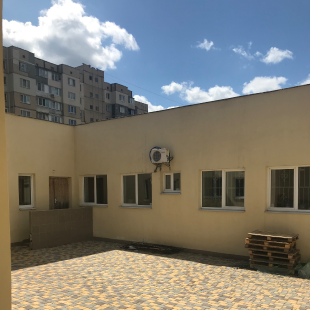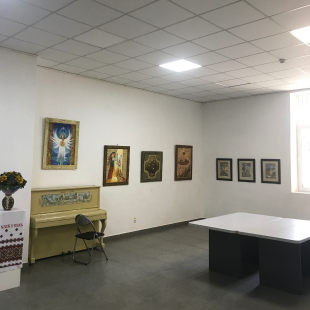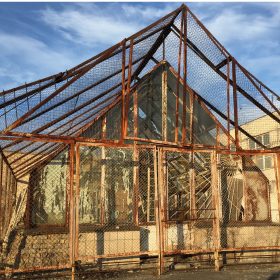







































































































































































































TRSHCHN PLATFORM is a multidisciplinary project that rethinks the phenomenon of the modern dormitory areas as a vacuum social environment; analyzes the causes and effects of the changes that have taken place since district`s creation and promotes cross-sectoral projects, which transform and develop the chosen locality, enhancing the progressive and diverse daily life of the residents of the area.
The aim of the project is to promote the idea of collective artistic and urban initiatives, creative and research interventions that would contribute to the anti-isolation of the area and create conditions in which locals would feel at the center of cultural events.
The urgency of the project maneuvers around two concepts that are important to modern Ukraine.
First, the phenomenon of decentralization in times of war and cramped borders, secondly, the law on decommunization and the propaganda of depreciation of artifacts of the Soviet era (numerous examples of the destruction of buildings, mosaics, sculptures, etc.)
TRSHCHN platform multimedia
a project that transports the housing estate of Troyeshchyna, which is the largest in Ukraine and has more than 300,000 inhabitants, into the virtual space and opens its history and attractions in the new media resource.
territory scanning, interactive VR guide, a device that maps the most significant points in a social, cultural, political context and develops an open interface and mechanism for interacting with information from researchers, urbanists, cultural scientists, sociologists, environmentalists, artists, locals, etc.
a 3D modelation of an abandoned church on the outskirts of Troieshchyna and the Kyiv border.
The platform will include this facility, which will become the main exhibition space of Troyeshchyna in digital. Also, this project raises the question of the need to create a cultural center in Troyeshchyna.
will include research materials and media archives of art projects that have been created in Troyeshchyna or about it or which have any alternative urban-spatial themes.
The monuments of Soviet modernism architecture and the local rhythm of life will serve as a source for theoretical, practical and innovative reflection, as well as for the future revitalization of the cultural space of the dormitory area.
However, in the face of resource and management shortages in planning and building, urban workshops, art interventions, and other artistic and research practices are perhaps the only condition for meaningful dialogue between the community, professionals from different industries, artists and government agencies.
Today, in every post-Soviet city there are many forgotten works of architecture and art, abandoned industrial and communal buildings. In our project, all this will become a material for rethinking and tactical revitalization of the cultural space of the area.
However, today there are no large-scale surveys of residential areas in Ukraine that would offer a thorough analysis and rethinking of the late Soviet period.
Accordingly, the largest centers of this era are the residential arrays, which still retain original examples of planning compositions, the typology of experimental housing, the structure of public buildings, and models of monumental art that require professional study.
Troyeshchyna is an unsurpassed example of a “museum district”, a space of relics of the Soviet life.
The project explores and tactically transforms public space, including abandoned locations that need renewal, focusing on exploring the physical and symbolic scheme of the city.
projections within public places, including on an inactive fountain and glass houses. In this way, we focus on the revitalization of abandoned places to tactically fill up abandoned state property.
The project's authors propose to begin a process of qualitative change from the space of the first Municipal Art Gallery, which began to function not in the city's cultural centers, but in the "heart" of the downtown metropolitan area, near the McDonald's, the police department, a new stadium, library and even a recycling center
It is important for our project that curators are connected by personal experience of life in Troieshchyna, so our ideas have arisen independently, the synergy of thoughts has connected us and pushed to new steps of realization of artistic and conceptual ideas in order to overcome isolation conditions of existence within the area
The platform engages researchers, software developers, theorists/ practitioners of modern social interaction tools, artists, art critics, philosophers, cultural scientists, architects, urbanists, etc.



We propose to begin a process of qualitative change from the space of the first Municipal Gallery, which began to function not in the city's cultural centers, but in the "heart" of the downtown metropolitan area, near the McDonald's, the police department, a new stadium, library and even a recycling center
The district is an architectural embodiment of the mass industrial construction era, which began in the mid-1950s under the leadership of M. Khrushchev and became the basis of further housing policy

Since the 2000s, there has been an active development of trade and services: residential areas are overgrown with shopping and entertainment centers, and the old department stores are being reconstructed uncontrollably.
The feeling of the uncontrolled disappearance of iconic public buildings, as libraries, houses of culture, cinemas, sculptures, etc., caused a public interest in the architectural heritage of the 1970s and 1980s, which was reflected in a number of research initiatives and publications, such as: “The Red Book” of the missing Soviet mosaics by Yevgeny Nikiforov, publication of the study “Unknown Left Bank” by Semyon Shirochin, Alexander Mikhailuk and Kirill Stepants, and “Remembering the Vinogradar” by Igor Odnopozov and others.


Remote from the center, which, in the absence of the long-awaited metro branch, the district is isolated from the cultural and business life of the city, is "bedroom" in the direct sense. Most residents who are forced to commute to a business center or an industrial area every day return only for overnight stays. However, a large proportion of residents often do not travel outside the district whose infrastructure is capable to satisfy basic needs. Shopping complexes are becoming a place of leisure for many people, primarily because of the lack of any alternatives. Unfortunately, the periphery situation has shaped and continues to form a negative image of the area - lack of conditions for the growth of cultural and economic capital of inhabitants.
Monoculture, segregation, household and street aggression - are the consequences of limited opportunities



